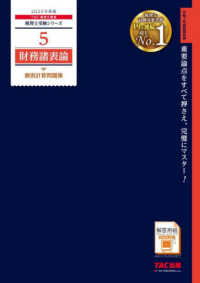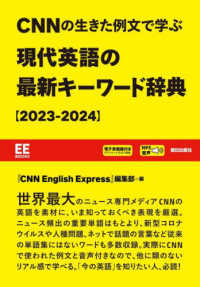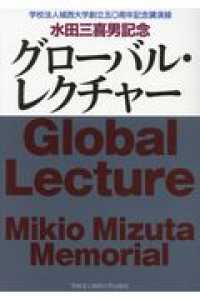- ホーム
- > 洋書
- > 英文書
- > Business / Economics
Full Description
The steel industry provides much of the material basis for modern civilisation. Although its end products are numerous, the largest sector of the industry is involved in the production of wide strip. This is used by countless other industries to make a range of products from automobile bodies, and the cases of domestic appliances, to metal furniture and cans for the preservation of foodstuffs and drinks. A hundred years ago sheet steel was made in labor-intensive operations by a large number of small rolling mills. This is an account of how this relatively backward part of the industry was transformed by the invention and industrial application of a revolutionary new technology. In the hot strip mill a slab of steel was passed through a series of rolls to be reduced into a continuous band of wide strip, which was then shipped either as coils or cut into sheets.
The introduction of the wide continuous hot strip mill began to concentrate the sheet and tin plate industry into much bigger operations complete with iron making, steel works, rolling mills and finishing plant. New companies rose to prominence; some old industry leaders fell behind. Many former locations for sheet manufacture were abandoned, but other old plants and companies re-equipped and survived. Major producers of other products entered the new trade. Less than thirty years ago another major change began when electric arc steel furnace operators began to install strip mills and the trade of the now rather inappropriately named `mini-mill` grew rapidly at the expense of the longer established iron—open hearth steel—primary rolling mill—strip mill industry. Now, as its centenary approaches, the strip mill sector is still undergoing major changes. This book surveys the growth, structure and changes in this dominant part of the steel industry. The strip mill has transformed steel world-wide, but in its origins and development it has above all been a distinctively American achievement.
Contents
Introduction: Innovation and Continuous Rolling Mills
Abbreviations
Chapter 1: Foundations: The Sheet and Tin Plate Industries to the Late Nineteenth Century
Chapter 2: Growth, Combination and Rationalization, 1898-1901
Chapter 3: Vandergrift Works
Chapter 4: Expansion and Company Promotion, 1900-1920
Chapter 5: A Great Divide: The Sheet Trade in the 1920s
Chapter 6: The Search for a Practicable Continuous Sheet Mill
Chapter 7: The Wide Continuous Hot Strip Mill
Chapter 8: Investment in Adverse Times: The Thirties
Chapter 9: Contrasts in Development Planning: Policies in the Pittsburgh District and Opportunities and Initiatives in Michigan
Chapter 10: Hand Mills, Continuous Mills, and Social Problems
Chapter 11: World War Ii and the Postwar Boom
Chapter 12: Corporate Policy after 1945
Chapter 13: The "Second Generation" Mills
Chapter 14: Years of Difficulty: The 1970s and 1980s
Chapter 15: EAF Steel and Compact Strip Mills
Chapter 16: Into a New Millennium
Appendix: The Old Sheet Steel Industry and Contrasting Perspectives on the Impact of the Strip Mill on Employment







